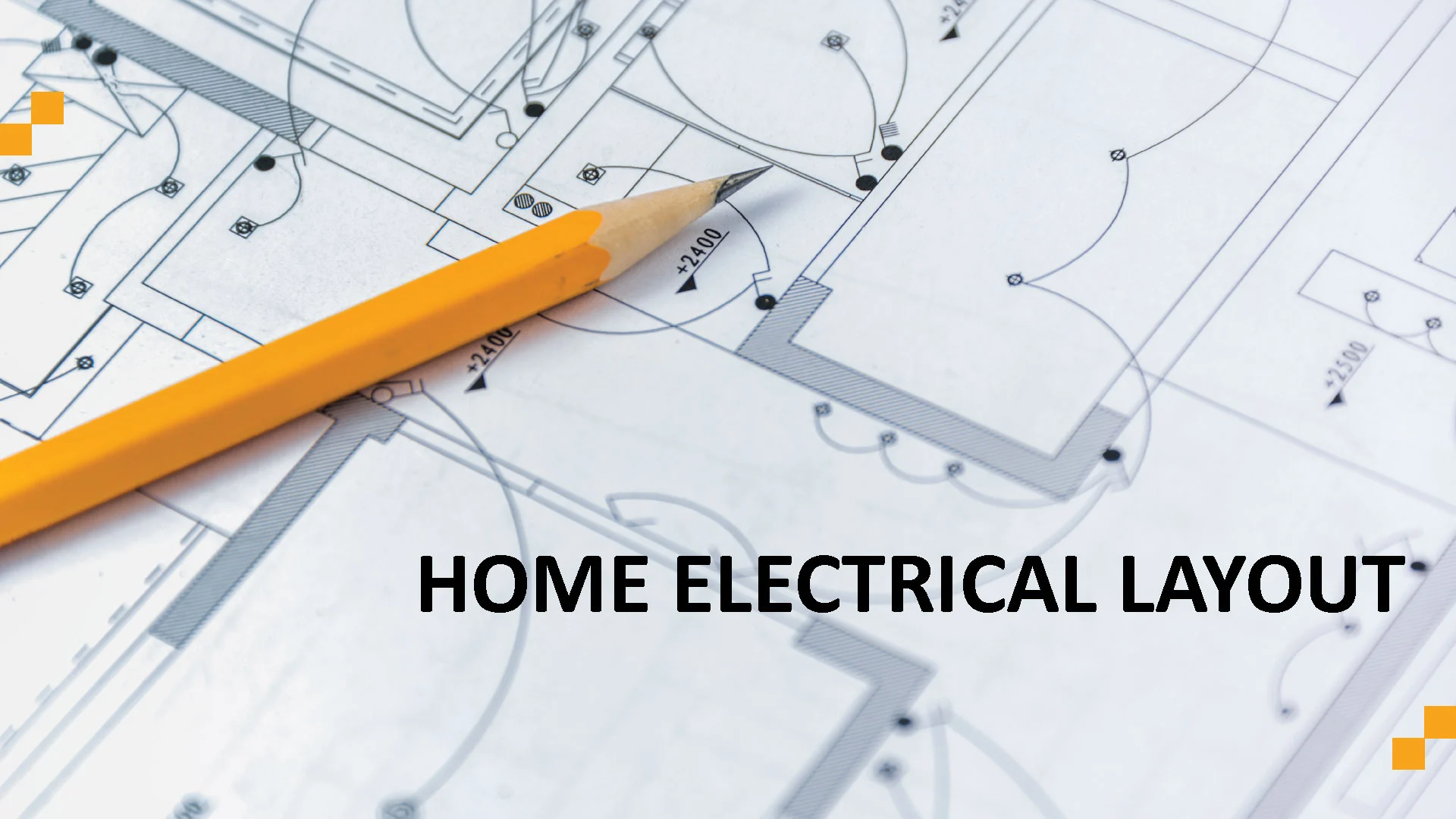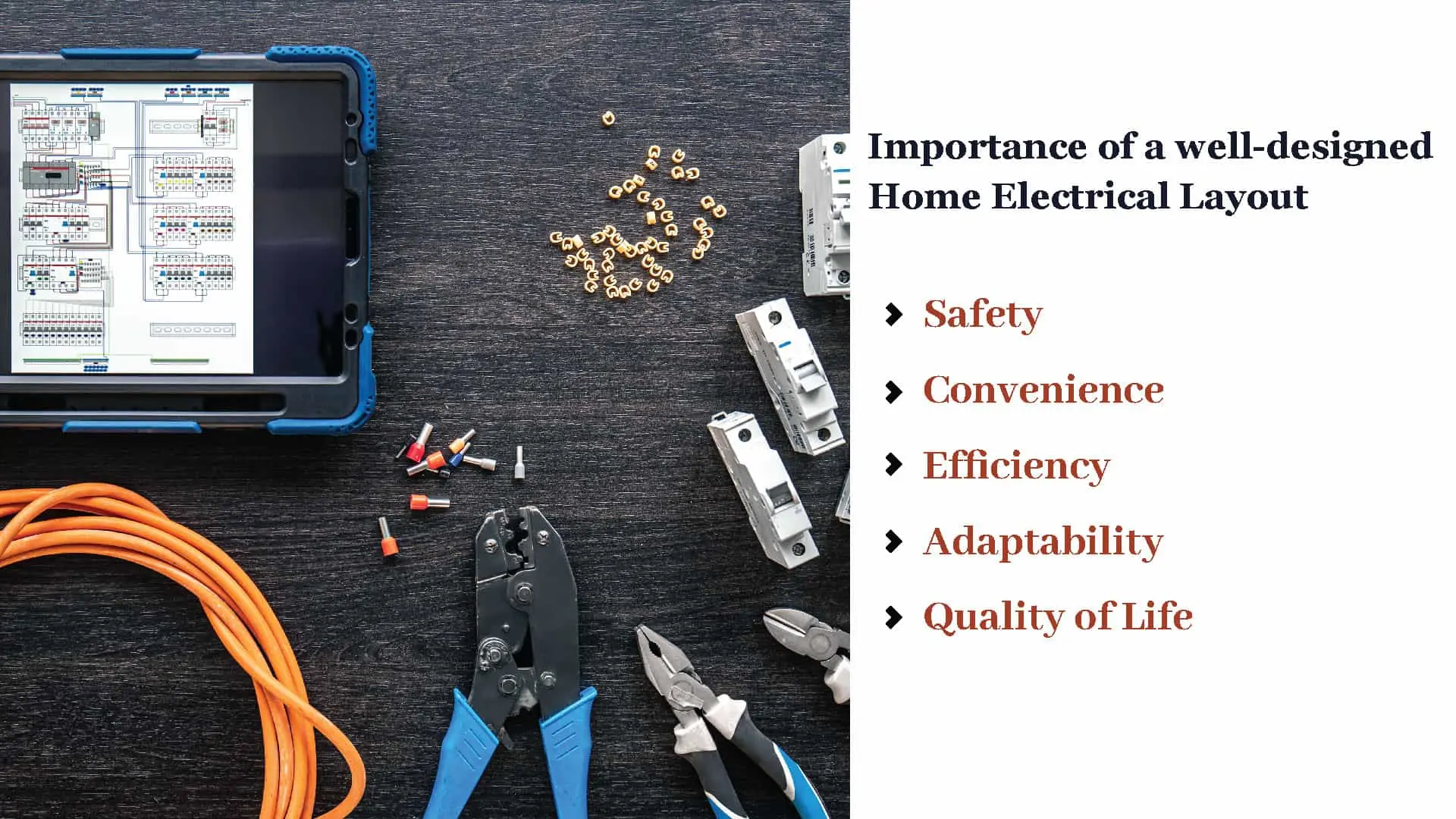In the heart of every home lies a hidden web of power. It connects the inhabitants to a world of convenience, safety, and efficiency. This intricate network, known as the home electrical layout, holds the key to a harmonious and functional living space.
Imagine stepping into a house where every corner gleams with brilliance, where devices hum with efficiency, and where safety is inherited in every aspect of the house. This delightful experience is possible by implementing a well-functioning home electrical layout.
Make My House truly understands the profound importance of a well-designed electrical layout. The below points are a comprehensive guide to understand the various factors of a home electrical layout. They will also extend a detailed understanding of the various factors of a electrical plan along with its importance.
Why an effective home electrical layout is necessary?
Safety:
Safety stands at the forefront of any well-functioning home electrical layout. The design and implementation of reliable grounding systems, circuit breakers, and protective devices ensure that the home is shielded from electrical hazards. Faulty wiring, overloaded circuits, or inadequate safety measures can lead to shocks, fires, and other dangerous situations. A thoughtfully planned electrical layout, crafted with the guidance of professionals, safeguards the well-being of both the home’s inhabitants and their precious belongings.
Convenience:
A well-designed electrical layout embraces the magic of convenience, transforming daily routines into seamless experiences. Thoughtful placement of outlets, switches, and lighting fixtures throughout the home has to be ensured for easy access to power where it is needed most. From the kitchen to the bedrooms and, living room to the home office, an abundance of well-positioned outlets completely wipes out the frustrations of tangled cords and limited power sources.
With the aid of USB outlets and integrated charging stations, the charging of smartphones, tablets, and other devices becomes an effortless task, freeing the inhabitants from the shackles of adaptors and cables.
Efficiency:
Living Efficiency is a guiding principle behind a well-functioning electrical layout. Through the intelligent use of energy-saving technologies and practices, the layout strives to minimize energy consumption and reduce environmental impact. Energy-efficient lighting, such as LED bulbs and fixtures, not only illuminates spaces with brilliance but also significantly lowers electricity usage.
The integration of smart home technologies allows for intelligent energy management, empowering homeowners to optimize energy consumption by controlling lighting, heating, and cooling systems remotely. By reducing energy waste, a well-designed electrical layout not only lowers utility bills but also contributes to a sustainable future.
Adaptability:
In an era of rapid technological advancement, a well-functioning electrical layout serves as a bridge to the future. It embraces adaptability, allowing homeowners to seamlessly integrate emerging technologies into their living spaces. The inclusion of dedicated circuits for high-power appliances ensures compatibility with evolving household needs, such as electric vehicle chargers, advanced home automation systems, or augmented reality devices. By future-proofing the home’s electrical infrastructure, a well-designed electrical wiring plan enables homeowners to effortlessly embrace the technological wonders of tomorrow.
Quality of Life:
Beyond the practicalities, a well-functioning electrical layout significantly impacts the overall quality of life within a home. Carefully planned lighting schemes, incorporating task lighting for focused activities and ambient lighting for relaxation, create an atmosphere that enhances comfort and well-being.
The ability to control lighting levels through dimmer switches adds versatility, allowing inhabitants to tailor the ambiance to suit their moods and activities. A thoughtfully designed electrical layout, with its intuitive integration of technology and comfort, fosters an environment where inhabitants can thrive and find solace.
As we dive deeper in the world of technology, almost at every step we need a great electrical supply. Almost every device we use needs charging to work in a well-functioning manner. The importance of a properly designed and implemented electrical system becomes abundantly clear. It forms the foundation for safety, convenience, efficiency, and adaptability. The next section includes the various risks involved with an inefficient electrical system.
Risks involved with an ineffective electrical layout.
An efficient and well-designed electrical layout is essential for the safe and reliable operation of any building or facility. A nonfunctional home electrical layout, on the other hand, poses various risks that can compromise the functionality, safety, and efficiency of the electrical system. Let us go through the potential dangers associated with a nonfunctional electrical layout.
Electrical Hazards:
One of the primary risks of a nonfunctional electrical layout is the increased potential for electrical hazards. Poorly placed outlets, inadequate grounding, faulty wiring, or improper circuit design can result in electric shocks, fires, or even electrocution. These hazards pose a serious threat to the occupants of the building, as well as the property itself.
Fire Hazards:
A nonfunctional electrical layout can significantly increase the risk of fire hazards. Faulty wiring, overloaded circuits, or improper installation of electrical devices can lead to overheating and short circuits. Excessive heat generation can cause insulation to melt or ignite, potentially triggering a fire. Moreover, if the electrical system lacks appropriate safety measures, such as circuit breakers or ground fault circuit interrupters (GFCIs), the chances of a fire spreading rapidly increase.
Power Interruptions and Equipment Damage:
An inefficient electrical layout can result in power interruptions and equipment damage. Inadequate distribution of electrical outlets or improper circuit sizing can lead to overloaded circuits, causing frequent tripping of circuit breakers. This can disrupt the power supply to critical equipment, leading to operational disruptions, data loss, or damage to sensitive electronic devices.
Inefficient Energy Consumption:
A nonfunctional electrical layout can also contribute to inefficient energy consumption. Improper placement of lighting fixtures, insufficient control systems, or lack of energy-efficient equipment can result in excessive energy usage. This leads to higher utility bills and a larger carbon footprint. A well-designed electrical layout can incorporate energy-saving measures such as motion sensors, timers, and efficient lighting systems. It works to optimize energy consumption.

Compliance and Legal Issues:
A nonfunctional electrical layout that fails to meet electrical codes and regulations can expose the building owner or facility manager to compliance and legal issues. Local electrical codes have been established to ensure the safety of occupants and the proper functioning of electrical systems. Noncompliance can result in fines, penalties, or even the closure of the facility until the issues are resolved. It is crucial to work with licensed professionals who are knowledgeable about electrical regulations and standards to avoid legal complications.
To end with
A nonfunctional electrical layout poses significant risks to the safety, efficiency, and functionality of a building’s electrical system. The potential hazards include electrical shocks, fires, equipment damage, power interruptions, and inefficient energy consumption. To mitigate these risks, it is crucial to invest in a well-designed electrical layout. It should be implemented by licensed professionals who adhere to electrical codes and regulations. Prioritizing electrical safety not only safeguards occupants and property but also ensures smooth operations and minimizes costly downtime associated with electrical failures.
Frequently Asked Questions about a well-designed electrical layout system
Q: What is an efficient electrical layout system?
An efficient electrical layout system refers to a well-designed and properly implemented electrical infrastructure within a building. It includes the strategic placement of outlets, switches, and circuitry, as well as considerations for safety, energy efficiency, and future adaptability.
Q: How does an efficient home electrical layout system enhance safety?
An efficient electrical layout system enhances safety by incorporating proper grounding and bonding to minimize the risk of electrical shocks. Installation of safety devices like GFCIs and circuit breakers are done to detect and prevent electrical faults. To prevent overloading and overheating properly sized circuits and use of appropriate wiring materials is ensured.
Q: What are the common causes of an ineffective electrical layout system?
Some common causes include inadequate planning, lack of professional expertise and, improper electrical wiring techniques. Insufficient consideration of electrical loads, failure to comply with electrical codes and regulations as well as inadequate maintenance are also some of the common causes.
Q: Can an ineffective electrical layout system lead to electrical shocks or electrocution?
Yes, an ineffective electrical layout system can increase the risk of electrical shocks or electrocution due to faulty wiring, improper grounding, or inadequate insulation.
Q: Are there legal implications associated with an ineffective electrical layout system?
Yes, an ineffective electrical layout system can violate building codes and safety regulations, potentially leading to legal and compliance issues.
Q: How can an ineffective home electrical layout system impact energy consumption?
Inefficient placement of outlets, improper lighting design, and inefficient use of electrical equipment can result in wasted energy and higher utility bills.












One thought on “Importance of a Well-Structured Home Electrical Layout”